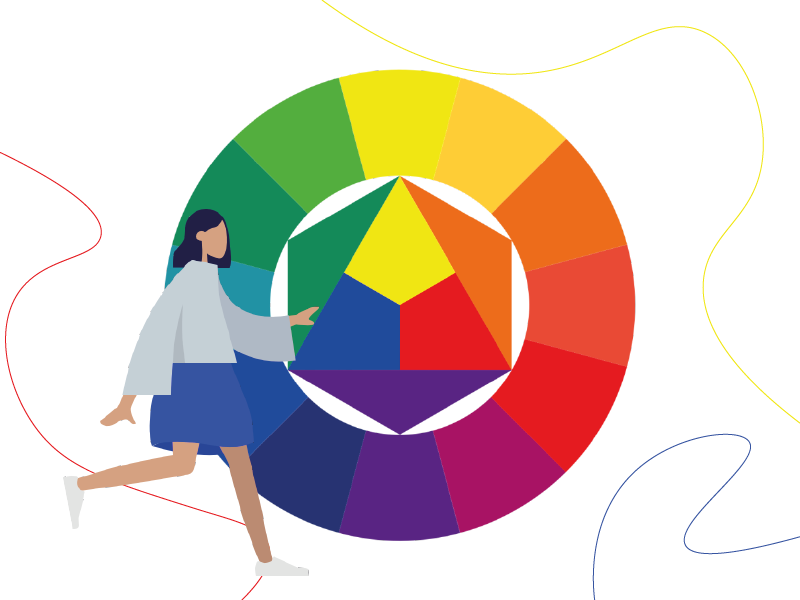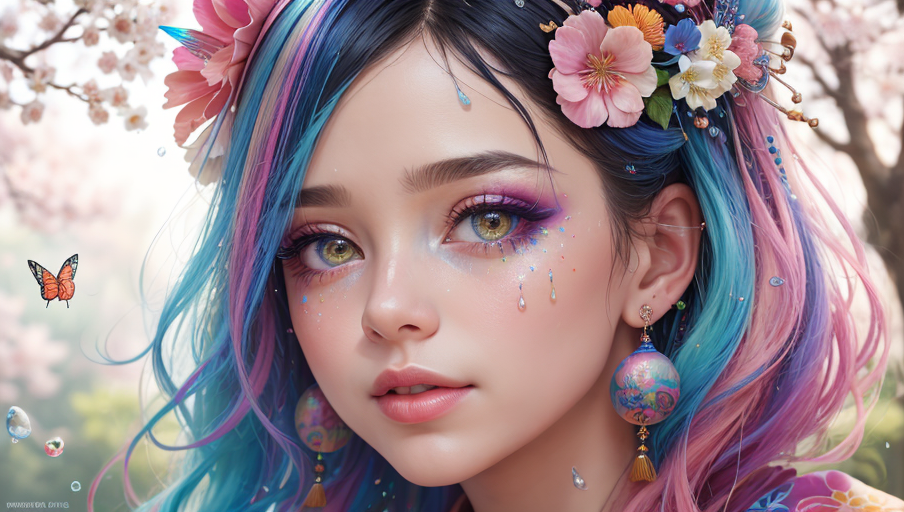Welcome to the complete guide to color theory and its application. Whether you’re a graphic designer, artist, marketer, or simply someone interested in the world of color, this comprehensive guide will take you on a journey through the fascinating realm of colors and their profound impact on our visual experiences.
What is Color Theory?
The study of color interactions is known as color theory. It focuses on the fundamentals of color theory, including harmony, contrast, and saturation, as well as how to combine color combinations to make a visual effect. You can learn to produce visually appealing works of art by comprehending these ideas. In this manual, we’ll examine the many methods of color theory and offer helpful hints for using them in your artwork. Also, we’ll talk about some of the crucial components of color theory, like the color wheel, basic colors, and complimentary hues. With this information at your disposal, you’ll be equipped to create remarkable works of art!
Why Color Theory is important?
Any artist or designer must have an excellent understanding of color theory. It enables them to produce visually appealing artwork that captures viewers’ attention. Understanding how colors interact allows designers to successfully convey specific feelings and produce designs that flow together. Additionally, color theory offers a fundamental framework for learning more complex techniques like accurately blending colors and coming up with harmonious color schemes.

Color Theory Application in Real-World Examples
Now that you are familiar with the fundamentals of color theory, let’s look at some examples of how this information might be used in the real world. Branding: Companies utilize color to stand out from rivals and build an emotional connection with their audience. Because red is linked to vigor, enthusiasm, and joy, Coca-Cola employs it as its main brand color. Interior Design – In interior design projects, the use of colors is crucial for achieving a harmonious ambiance. For instance, bright colors like yellows and oranges tend to be more energetic than cold hues like blues and greens, which frequently induce feelings of tranquility and relaxation.
For instance, lighter colors should be utilized for text and other items that need to stand out whereas dark colors are best used as backgrounds.

How do I use Color Theory?
Although it is not difficult to learn how to use color theory, it does need time and effort. Learning the basics of the color wheel, primary colors, and complimentary colors is the best place to start. After you’ve established a strong foundation, you might want to experiment with other strategies, such color palettes. Try out several color schemes and combinations until you discover those that are most effective for your project. Everyone can use color theory to turn their endeavors into masterpieces with the correct knowledge (and some experience).
The Color Wheel
A circular diagram that shows the relationship between colors is called a color wheel. It serves as a tool to assist artists and designers in choosing visually appealing color combinations and schemes. Three fundamental colors—red, blue, and yellow—three secondary colors—purple, green, and orange—and six tertiary colors, which are produced by combining primary and secondary colors, make up the color wheel. The color wheel aids in the explanation of key color theory ideas such monochromatic colors, analogous colors, and complimentary colors.
Primary colors:
The basic colors known as primary colors are those that cannot be made by combining other colors. Red, blue, and yellow are the three basic hues. These main colors are combined in various amounts and ratios to produce all other colors.
Secondary colors:
By combining two primary colors equally, secondary colors can be produced. Green (a combination of blue and yellow), orange (a combination of red and yellow), and purple make up the three secondary hues (mixed with blue and red).
Tertiary colors:
By combining a primary color with one of its neighboring secondary hues, tertiary colors are produced. For instance, red-orange is produced by combining red (primary) and orange (secondary). Red-orange, yellow-orange, yellow-green, blue-green, blue-purple, and red-purple are the six tertiary hues. They are frequently utilized in design and art, where they give color schemes depth and intricacy.
Color Properties
It’s critical to familiarize yourself with the many aspects of color in order to comprehend how colors function. Color, saturation, value, and intensity are a few of them.
Hue
Hue is the characteristic of a color that enables us to tell it apart from other colors. It is the characteristic that describes the predominant light wavelength and the viewed color. Hue can also be used to describe a pigment’s true color, such as red, blue, or green. The terms hue and color are frequently used synonymously.
Saturation
The intensity or purity of a color is described by saturation, which is frequently used interchangeably with intensity or chroma. Chroma is another name for it. A color that is highly saturated is one that is vivid and bright, whereas a color that is low in saturation appears washed out or subdued. In other terms, saturation describes the amount of gray in a color. Grey is more prevalent in colors with low saturation, while grey is scarce to nonexistent in hues with high saturation. Because it can effect the overall emotional impact and tone of a design or piece of art, saturation is a crucial component of color theory.
Value
Value, which is used similarly with luma, describes how light or dark a color is. Tone is another name for it. Value is a crucial component of color theory since it can influence the mood and contrast of a design or piece of art. A light color has a high value, whereas a dark color has a low value. An artist or designer can add depth, dimension, and texture by changing the value of a color. Also, the application of value can aid in establishing a focus point and directing the viewer’s eye toward crucial components in a design or piece of art. Understanding these characteristics will help you accurately combine colors and produce pleasant visual effects.

How do I use the Color Wheel?
As soon as you understand the fundamentals of the color wheel, you may begin to investigate more sophisticated strategies like contrast and harmony. Furthermore, tinting and shading can aid in giving your artwork depth and a cohesive appearance.
Contrast
When two colors are placed next to each other on the color wheel, contrast is produced. This gives your artwork a distinctive appearance and can be used to highlight particular features or call attention to particular regions of your work.
Harmony
When different colors are used in a way that is aesthetically pleasant, like using analogous hues or monochromatic palettes, harmony is established. It still enables you to exercise your creative freedom while giving your artwork a unified and balanced appearance.
Tinting and Shading
While shading entails darkening colors with black, tinting refers to the process of adding white to hues to make them lighter. Shades and tints give objects depth and dimension.
Color Psychology and Emotion and Applications
The influence of colors on our emotions and behavior is studied in color psychology. Each color has the capacity to cause viewers to feel a certain way. Red, for example, evokes a sense of haste or excitement, whereas blue inspires peace and tranquility. Having a knowledge of color psychology can help you produce more effective designs. Artists and designers can consciously use color to convey feelings, establish contrast, and draw the viewer’s eye to a design or piece of art. Here are some typical hues, their emotional connotations, and examples from daily life:
Red
Positive effects
Passion, energy, excitement Example: Coca-Cola uses red in their branding to evoke excitement and energy, and their distinct red color has become a hallmark of their brand.
Negative effects
Anger, danger Example: Red warning signs use the color to grab people’s attention and create a sense of urgency or danger.
Orange
Positive effects
Enthusiasm, warmth, fun Example: The Home Depot uses orange in their branding to create a warm and welcoming atmosphere, conveying the message of an approachable and helpful brand.
Negative effects
Frustration, restlessness, hunger Example: Prisons commonly use orange jumpsuits on prisoners as a means of punishment.
Yellow
Positive effects
Happiness, positivity, optimism Example: Ikea uses yellow in their branding to create a sense of joy and optimism.
Negative effects
Caution, warnings Example: Yellow police tape is used as a warning to keep people away from crime scenes or other hazardous areas.
Green
Positive effects
growth, health, harmonyExample: Whole Foods Market uses green in their branding to convey a sense of natural and organic products, which aligns with the company’s values and mission.
Negative effects
Envy, greed Example: The green-eyed monster is often used as a metaphor for jealousy, and green is sometimes associated with greed and avarice.
Blue
Positive effects
Trust, serenity, stability Example: Facebook uses blue in their branding to create a sense of trust, reliability, and calmness.
Negative effects
Sadness, melancholy Example: Blue can evoke sadness or loneliness, and is sometimes used in the context of depression or sadness.
Purple
Positive effects
Creativity, luxury, spirituality Example: Yahoo uses purple in their branding to create a sense of creativity, imagination, and forward-thinking.
Negative effects
Nostalgia, sadness Example: In the context of mourning, purple is sometimes used as an alternative to black.
Pink
Positive effects
Romance, playfulness, gentleness Example: Barbie dolls are known for their distinct pink color, which conveys the brand’s playful and feminine image.
Negative effects
Immaturity Example: In the corporate world, pink is sometimes criticized for being overly feminine and lacking seriousness.
Black
Positive effects
Sophistication, elegance, power Example: Chanel uses black in their branding to create a sense of timeless elegance, luxury, and style.
Negative effects
Fear, negativity Example: Black can also evoke fear or negativity in certain contexts, such as black cats on Halloween.
White
Positive effects
Purity, cleanliness, simplicity Example: Apple uses white in their branding to create a sense of minimalism, simplicity, and sophistication.
Negative effects
Emptiness, negativity
Example: Stark white walls in a room may create a sense of emptiness or sterility, which may not be ideal for a cozy or warm atmosphere.

Color Schemes and their Meanings
Since they can influence both the viewer’s emotions and the entire visual experience, color schemes are important in both art and design. The most popular color schemes and their descriptions are shown below:
Monochromatic
While creating a monochromatic color scheme, several hues, tones, and shades of the same color are used. This has a calming and unified impact. Meaning: A monochromatic color scheme might imply steadiness, composure, and simplicity, resulting in the creation of a tranquil and calming environment. An illustration of this is Apple’s branding, which conveys sophistication and simplicity by employing a monochrome white color scheme on both their goods and advertising.
Analogous
Using hues that are close to one another on the color wheel is referred to as an analogous color scheme. This has a tranquil and organic vibe. Meaning: Although still bringing some variation and aesthetic appeal to the work, an analogous color palette can foster a tranquil and serene ambiance. For instance, Twitter’s blue-green color palette contributes to the brand’s relaxing and upbeat perception.
Complementary
Colors that are opposite one another on the color wheel are combined to produce a complimentary color scheme. This produces a striking contrast effect that might draw in the spectator. Meaning: By producing a dramatic contrast between hues, a complementary color scheme can produce a lively and energizing ambiance. For instance, the Amazon logo’s red and yellow color scheme makes the brand name stand out.
Triadic
Using three hues that are evenly spaced apart on the color wheel is known as a triadic color scheme. This produces a lively and well-balanced result. Meaning: A triadic color scheme maintains color harmony while producing a dynamic and energizing ambiance. As an illustration, the triadic color scheme of black, white, and red is frequently used in the branding of Adidas to convey a dynamic and strong image.
Tetradic
Two complementary color pairs are combined to provide a tetradic color system. This has a bold, energetic effect. Tetradic color schemes produce a bold and adventurous atmosphere that exudes a sense of authority and power. For instance, the branding for McDonald’s emphasizes the tetradic color scheme of red, yellow, green, and blue to project a lively and cheerful image. Artists and designers can improve their work and produce aesthetically appealing projects that elicit the necessary emotional response from the audience by learning the meanings and subtleties of various color schemes.
Color Harmony
It’s crucial to achieve harmony between all the colors in your design, regardless of what kind it is. Understanding color theory and its guiding principles will be useful in this situation. You can achieve harmonious, balanced color schemes in your designs by using the following advice: Choose a small color palette. You can better integrate each of the colors if you limit your options. Use contrast to highlight certain components of your design while keeping others understated and secondary. Using comparable or monochromatic color schemes is a terrific way to achieve harmony because they make use of related colours. Don’t use too many vibrant colors. For viewers, using too many vibrant hues might be overwhelming and distracting.
Color Context
Viewers’ perceptions of colors are also influenced by the context in which they are utilized. Consider the following advice when evaluating the context of color: Be aware of cultural connotations – While choosing colors, keep in mind that certain hues may have various connotations depending on where you are from. Consider the setting when choosing colors. For example, if you’re designing an outdoor space, go for earthy tones that will fit in with the surroundings. Use current trends to your advantage to prevent your design from appearing obsolete or out of place. Consider the lighting situation – Various lighting settings can have an impact on how colors are seen, so experiment to acquire the ideal result.
Color Contrast and Accessibility
The use of color in design is an useful tactic, but with great power comes tremendous responsibility. To ensure that all viewers can appreciate your work, it is crucial to keep accessibility and color contrast in mind when producing designs. Here are some pointers for making color contrast accessible: Unless you’re trying for a low-contrast design deliberately, choose colors with enough contrast to make your content simpler to read. See the WCAG specifications. How much color contrast should be utilized in web design projects is specified in the Web Content Accessibility Guidelines (WCAG). Utilize tools to assess color contrast – To make sure your colors have enough contrast, use online resources like Color Contrast Checker.
Using Color Theory in Practical Applications
It’s time to put some of the fundamental concepts of color theory into practice that you’ve studied about. You can get going with the help of the following advice:
- Start with a simple color scheme. Limit your possibilities and stay with a few complementary hues.
- Try out various combinations – Don’t be scared to experiment until you find a solution that suits your project.
- Utilize the color wheel as a guide while creating your design – this is a crucial tool.
- Get inspiration from nature – There are countless beautiful examples of how to use colors harmoniously in nature.
- Take attention to how colors make you feel – As different colors have distinct emotional effects, keep this in mind when you create your artwork.
- Choose a color scheme that fits your design: After learning about the various color schemes, you may select the one that most closely matches your design. For instance, you might use a monochromatic color scheme to produce a peaceful look. You might pick a complementary color palette if you want to make a vivid, high-contrast design.
- Try out various color combinations: After deciding on a color scheme, you can try out various color combinations within that scheme. You should experiment with each color’s various tones, tints, and shades to find the ideal combination for your design.
You may make designs that are both aesthetically beautiful and emotionally impactful that will stand out from the competition by comprehending and utilizing color theory principles. You may learn the fundamentals and build upon them with practice to produce beautiful works of art!
Final words
Thank you for sticking through this lengthy guide. I really admire your commitment to mastering color theory. Your recommendations will be considered to make sure that this manual is constantly upgraded. Always keep in mind that color theory is an essential part of every design job. Gaining a rudimentary understanding can enable you to produce designs with greater impact. While choosing colors, take into account their intended usage, context, color contrast, and accessibility. You may produce amazing pieces of art that are likely to draw people’s attention with experience and experimentation.






